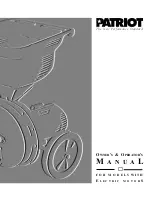
Bandit
46
Copyright 9/18
MODEL 15XP/1390
MAINTENANCE
27. Check tires:
Check tires for wear, air pressure, weather checking
and damage. Replace if damaged. Fill each tire to
rated capacity on tire.
28. Inspect axle dust caps:
Inspect axle dust caps and replace if damaged or
leaking.
29. Inspect, adjust, and lubricate tracks (if equipped):
Inspect, adjust, and lubricate tracks as needed per
track MFG. manual.
30. Check the infeed hopper:
Check in the infeed hopper for any foreign objects
and around the entire machine for tools, cans, saws,
etc. All tools not in use should be stored in a tool box.
31. Block the tires, tongue, and infeed hopper:
Before operation block the tires, tongue, and infeed
hopper for stability. Do not rely on tongue jack for
operational stabilization.
32. Check the discharge direction:
Remove transport bolt and nut, then make sure the
discharge is pointed in a safe direction and locked
into place.
33. Review all safety procedures on decals, from
manual, and from video.
34. Make sure all safety equipment is being worn:
Make sure you are wearing all of your safety
equipment: hard hat, face shield, gloves, eye
protection, ear protection, etc. per ANSI and OSHA
standards.
35. Remember to check EVERYTHING on the
checklist.
23. Check oil cooler (if equipped):
Thoroughly clean cooler fins at least once a day
or more in excessive conditions. Make sure debris
is not packed between fins. Use compressed air
and/or pressurized water (soap may also be needed)
to clean the oil cooler, depending on the level and
type of debris. If pressurized water is used, be careful
not to turn the debris hard and pack solid between
the cooler fins. Make sure to clean the cooler in the
correct direction; do not propel the debris into the
cooler with compressed air or pressurized water.
Keep the compressed air or pressurized water a safe
distance from the cooler fins and parallel to the fins
so they are not damaged. Visually inspect the cooler
fins and make sure they are not bent or closed off,
repair or replace as needed.
24. Check air cleaner and precleaner:
Clean or replace element following engine manual
recommendations. Also, check and clean the
vacuator valve.
25. Check clutch:
Check for proper lubrication, and engagement
tension adjustment, frequently adjust and lubricate
per PTO clutch manufacturer’s manual. Bandit
Industries, Inc.
does not warranty clutch failures.
26. Sliding tongue & hardware (if equipped):
Inspect sliding tongue and hardware for wear or
damage. If worn or damaged, replace immediately.
Make sure the sliding tongue bolts and automated
lock nuts are snugged up to the tongue bushings, but
still able to spin inside the bushings. Do not torque.
DAILY START UP & MAINTENANCE (cont.)
1. Check anvil clearance, tightness, and wear:
Measure the anvil clearance. The clearance should
be .120” (3.0 mm) from highest knife. Check the
anvil hardware, make sure the bolts are at the
proper torque. The anvil is a normal wear item, if
it is worn you can rotate it to a new working edge.
Refer to pages 58 - 59 for the exact checking of anvil
clearance procedure.
2. Check shear bar clearance, sharpness, and
tightness:
Every 50 hours of operation, measure the shear bar
clearance. The clearance should be .120” (3.0mm)
from highest knife. Make sure the shear counter
knives are sharp and have not lost their edge every
50 hours of operation. File, grind, or replace as
needed. A maximum of 1/8” (3.1 mm) can be ground
or filed off the shear counter knives. Check the shear
bar hardware, make sure the bolts are at the proper
torque. There is a shear bar on each side of the
chipper drum. Refer to pages 62 - 63 for the
exact checking of shear bar clearance procedure.
3. Check alternator and fan belts on engine:
Inspect belt condition and replace as needed.
As applicable adjust and maintain per the engine
manufacturer’s manual.
4. Check spring tension on feed system:
Do not over tighten. Keep tight for small diameter
material and progressively looser for larger diameter
material. See page 76.
5. Check wheel lug nuts:
Keep lug nuts tight, retorque, replace if needed.
6. Lubricate all steel friction areas:
Lubricate all steel friction areas including, but not
limited to pivoting, hinged, sliding, rotating areas on
the machine (i.e. control bar, folding tray, discharge
flipper, hyd. valves & linkages, height adjustable
discharge, discharge T-handle, hydraulic bump
bar, etc.)
7. Lubricate chain driven components:
Use a dry lube on any chain driven components:
hydraulic swivel discharge and chain driven
feedwheels.
WEEKLY MAINTENANCE
















































